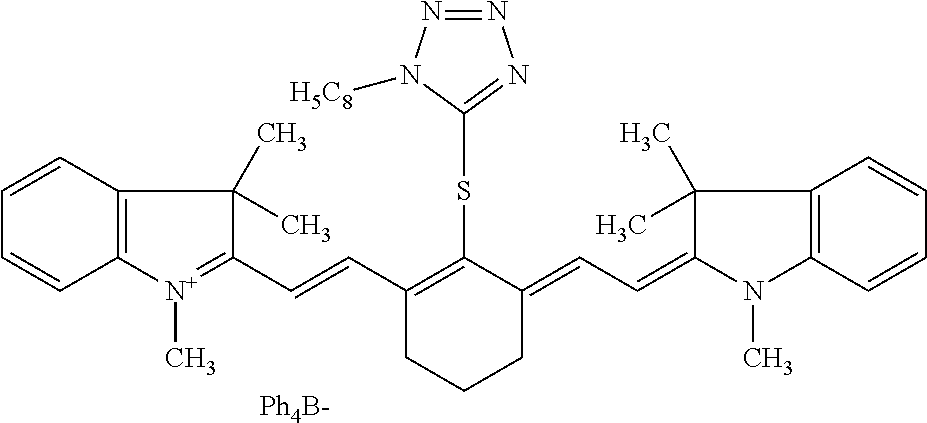Method for making lithographic printing plates
a technology lithographic printing plate, which is applied in the field of lithographic printing plate preparation, can solve the problems of excessive stickiness of exposed and processed precursors, impede normal pre-press and printing press operations, etc., and achieves low tackiness of lithographic printing plate, low negative effect of printing plate durability, and high loading capacity
- Summary
- Abstract
- Description
- Claims
- Application Information
AI Technical Summary
Benefits of technology
Problems solved by technology
Method used
Image
Examples
embodiment 1
[0209]2. The method of embodiment 1, wherein component (1) contains no ionic group.
[0210]3. The method of embodiment 1 or 2, wherein component (1) contains no carboxylic acid group.
[0211]4. The method of any of embodiments 1 to 3, wherein component (1) is present in the processing solution in an amount of at least 1 weight % and up to and including 10 weight %, based on total processing solution weight, and component (1) is selected from the group consisting of:
[0212]2-amino-2-hydroxymethyl-propane-1,3-diol, 1,3-bis(tris(hydroxymethyl)methylamino)propane, bis(2-hydroxyethyl)-amino-tris(hydroxymethyl)-methane, triethylene diamine, melamine, piperazine, urotropine, poly(ethylene imine), glycine, alanine, 2-aminoethane sulfonic acid, 3-[[1,3-dihydroxy-2-(hydroxymethyl)propan-2-yl]amino]propane-1-sulfonic acid, 3-[[1,3-dihydroxy-2-(hydroxymethyl)propan-2-yl]amino]-2-hydroxypropane-1-sulfonic acid, N-[tris(hydroxymethyl)methyl]glycine, N,N-bis(2-hydroxyethyl)glycine, 2-(N-morpholino)etha...
embodiment 18
[0237]19. The method of embodiment 18, consisting essentially of (a) through (f), wherein (d) treating is carried out with two successive applications of the same processing solution.
[0238]The following Examples are provided to illustrate the practice of this invention and are not meant to be limiting in any manner. The following components were used in the Examples.
[0239]
Aerodisp ® 103030 weight % dispersion of surface modified silica particles inmethoxypropylacetate (EVONIK, Germany)Acticide ® LAA biocide (Thor Specialties, Inc.)1206Binder 1Copolymer derived from methacrylic acid, allyl methacrylate,and benzyl methacrylate, 20 / 60 / 20 molar ratioBinder 2Copolymer derived from methacrylic acid, methylmethacrylate, allyl methacrylate, and N-isopropylmethacrylamide, 20 / 20 / 40 / 20 molar ratioCIBBis-cumyliodonium tetraphenylborateBLOγ-Butyrolactone solventBYK ® 307Polyethoxylated dimethyl polysiloxane (BYK Chemie)o-Cl-HABI2,2′-Bis(2-chloropheny1)-4,4′,5,5′-tetraphenyl-1,1′-biimidazoleDowan...
PUM
| Property | Measurement | Unit |
|---|---|---|
| temperature | aaaaa | aaaaa |
| temperature | aaaaa | aaaaa |
| atmospheric pressure melting point | aaaaa | aaaaa |
Abstract
Description
Claims
Application Information
 Login to View More
Login to View More - R&D
- Intellectual Property
- Life Sciences
- Materials
- Tech Scout
- Unparalleled Data Quality
- Higher Quality Content
- 60% Fewer Hallucinations
Browse by: Latest US Patents, China's latest patents, Technical Efficacy Thesaurus, Application Domain, Technology Topic, Popular Technical Reports.
© 2025 PatSnap. All rights reserved.Legal|Privacy policy|Modern Slavery Act Transparency Statement|Sitemap|About US| Contact US: help@patsnap.com



